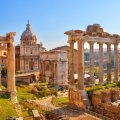FORO ROMANO (ROMAN FORUM)
It is the centre and symbol of the power of republican Rome. A sumptuous site that offers a true journey back in time.
The Roman Forum corresponds to the central area of republican Rome, the one that existed as a monumental city center, before the apprentice dictators, such as Silla or Caesar, tried to create their own center, and even more so, before the emperors intervened. However, the emperors did not neglect this space; they did intervene, modifying here and creating there. So much so that today it is not easy for the uninformed visitor to determine at first glance to which ruin among those that remain belonged. For the record, in 410 AD, Alaric, a barbarian leader, entered Rome. Fifty-one years later, the Western Roman Empire finally collapsed. From the VIth century onwards, a slow and inevitable decadence and destruction of the Forum begins, the materials of which will be used to build elsewhere. Only a few monuments were spared, as they were transformed into churches or palaces. Over the centuries, erosion, floods, landslides, destruction and earthquakes will raise the ground level by several meters. Up to 200 years ago, the Roman Forum, which was called Campo Vaccino, was a wasteland where cows grazed on the grass, since excavations had begun rather late.
However, with a little imagination, one can imagine the wealth and magnificence of this site, which the Romans, for ten centuries, considered the center and symbol of their power. From the end of the IInd century, this place was considered as a kind of museum; however, Septimius Severus (around 200) and Maxentius (310) still built sumptuous buildings there, at a time that History qualifies, a little quickly perhaps, as decadent. The site we are approaching is a vast quadrilateral 500 m long and 200 m wide, which, starting from its lowest point at the foot of the Capitol, slopes gently up to the Velia, the natural slope that connects Mount Palatine to the Esquiline.
The forum itself, the main square of ancient Rome, occupies only a very small part of this area. The buildings that are still standing can serve as landmarks.
As you enter the site, head towards the Capitol which dominates with all its mass. The Forum where we arrive is a trapezoidal space wedged between the Aemilia basilica, the Julia basilica and the base of the Capitol.
Did you know? This review was written by our professional authors.
Book the Best Activities with Get Your Guide
Members' reviews on FORO ROMANO (ROMAN FORUM)
The ratings and reviews below reflect the subjective opinions of members and not the opinion of The Little Witty.
Un saut dans le temps et l'histoire
Un guide est un plus utile car il permet de comprendre ce que chaque vestige représentait à quoi il servait et comment la société romaine y vivait
Find unique Stay Offers with our Partners












-un plan
-faire une démarche chronologique pour imaginer que l'ensemble sous nos yeux se développe en deux siècles
Je pense tout de même que la lecture de ces vestiges est certes assez complexe mais qu'il peut vraiment valoir la peine d'effectuer cet effort.